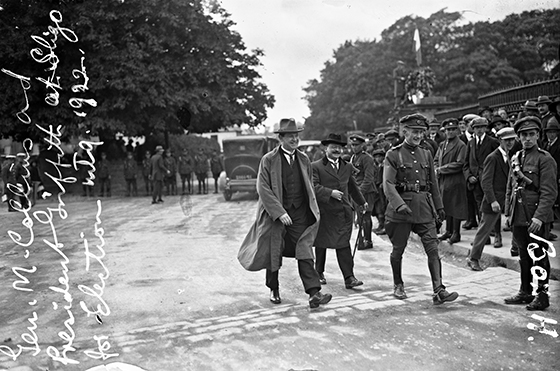Griffith in Longford (not Sligo)
Published in Issue 5 (September/October 2020), Letters, Volume 28Sir,—Your May/June 2020 issue kindly included a review by Owen McGee of my book The enigma of Arthur Griffith: ‘Father of Us All’ (Merrion Press). On the night that the book was launched, an enthusiastic historical researcher came armed with press cuttings to demonstrate during drinks that the caption on one of the photographs in the book is wrong.
This is not Griffith and Collins in Sligo for an election meeting in 1922, he said, but Griffith and Collins in Longford on 21 June 1922. A cutting from the Irish Independent supported him, for there was the very image identified as ‘Messrs. Arthur Griffith, Michael Collins and Comdt.-General Lawlor arriving at the Cathedral, Longford, for the wedding of General McKeon and Miss Alice Cooney yesterday’.

Above: The glass negative says ‘Gen. M. Collins and President Griffith at Sligo election mtg. 1922’, but in fact the picture appeared in the Irish Independent on 22 June 1922 captioned ‘Messrs. Arthur Griffith, Michael Collins and Comdt.-General Lawlor arriving at the Cathedral, Longford, for the wedding of General McKeon and Miss Alice Cooney yesterday’. (NLI)
It is a cautionary tale. I had relied on the catalogue of the National Library of Ireland, which itself understandably depended on the original inscription on a glass negative from the Irish Independent. But what is perhaps most interesting about the photo is the happy and robust appearance of the men, whose pro-Treaty side had just fared well in the general election. Griffith’s ill health had worried Collins during the Treaty negotiations and he was to drop dead less than eight weeks after this photograph was taken. On the day that it was published the IRA shot dead Sir Henry Wilson in London, in what Griffith condemned as ‘an anarchic deed’. Within a week the occupied Four Courts were shelled.
Towards the end of his review Owen McGee chides me gently, for I appear to him to have ‘accepted uncritically’ Gogarty’s statement that ‘from a dual monarchy for Ireland Griffith never advanced’ (p. 229). Oliver Gogarty, however, was the doctor who attended when Griffith suddenly died, and quoting part of his tribute to him without challenging it directly is not an endorsement. I trust that my book overall makes it clear that Griffith, who had joined the IRB and attended a key planning meeting with the future signatories of the 1916 proclamation, was a democrat and pragmatist who desired maximum independence for the whole island of Ireland. He was not a monarchist in anything but a strategic sense. My view is at one with Patrick Maume, whom I also quoted uncritically (p. 247) and who has written that ‘Griffith was more republican than is generally realised’.—Yours etc.,
COLUM KENNY
















